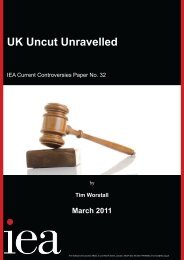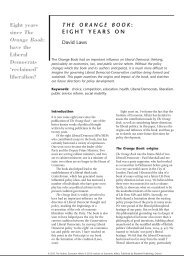… and the Pursuit of Happiness - Institute of Economic Affairs
… and the Pursuit of Happiness - Institute of Economic Affairs
… and the Pursuit of Happiness - Institute of Economic Affairs
Create successful ePaper yourself
Turn your PDF publications into a flip-book with our unique Google optimized e-Paper software.
<strong>…</strong> <strong>and</strong> <strong>the</strong> pursuit <strong>of</strong> happiness<br />
<strong>the</strong> folly <strong>of</strong> wellbeing in public policy<br />
US economy with <strong>the</strong> title ‘The use <strong>of</strong> econometric models as a<br />
guide to economic policy’ (see Klein, 1947).<br />
So <strong>the</strong> process <strong>of</strong> measuring <strong>the</strong> economy metamorphosed<br />
almost overnight into <strong>the</strong> desire to use <strong>the</strong>se measurements to<br />
predict <strong>and</strong> control it, exactly as is <strong>the</strong> case with happiness today.<br />
Enormous optimism was expressed about <strong>the</strong>se possibilities,<br />
despite <strong>the</strong> salutary experience <strong>of</strong> <strong>the</strong> spectacular failures <strong>of</strong> forecasts<br />
carried out in <strong>the</strong> summer <strong>of</strong> 1945 for <strong>the</strong> rest <strong>of</strong> that year<br />
<strong>and</strong> for 1946. Klein himself documented <strong>the</strong> errors in an article<br />
(see Klein, 1946). Unemployment, for example, had been forecast<br />
to be 8 million but was only 3 million. But he argued that output<br />
could be predicted much more accurately, <strong>and</strong> that <strong>the</strong> correct<br />
application <strong>of</strong> econometrics to this data meant that ‘we can look<br />
forward to much better results in <strong>the</strong> post-transition period’.<br />
Over 60 years on, we have a massive literature on all <strong>the</strong><br />
nuances <strong>of</strong> economic forecasting, spanning a wide range <strong>of</strong> statistical<br />
techniques <strong>and</strong> economic <strong>the</strong>ories, far more sophisticated<br />
than <strong>the</strong> highly innovative but ra<strong>the</strong>r crude methods <strong>of</strong> Klein in<br />
<strong>the</strong> 1940s. But it is no exaggeration to say that no progress has<br />
been made in <strong>the</strong> accuracy <strong>of</strong> forecasts. At key times, <strong>the</strong> onsets<br />
<strong>of</strong> booms or recessions, forecasts prove just as inaccurate as <strong>the</strong>y<br />
were in 1945. The Bank <strong>of</strong> Engl<strong>and</strong> Quarterly Bulletin in October<br />
2008, for example, shows that <strong>the</strong> consensus forecast for UK <strong>and</strong><br />
US GDP growth in 2009 in January 2008 was for positive growth<br />
<strong>of</strong> 2.0 <strong>and</strong> 2.7 per cent respectively. As late as August, <strong>the</strong> forecasts<br />
were still for positive growth, despite <strong>the</strong> fact that by <strong>the</strong>n<br />
both economies were in recession <strong>and</strong> output was already falling!<br />
The actual out-turn for 2009 was negative growth <strong>of</strong> 3 per cent in<br />
America <strong>and</strong> 5 per cent in Britain. There are many such examples.<br />
It is not just that we cannot predict <strong>the</strong> economy with<br />
any reasonable level <strong>of</strong> systematic accuracy. We still have no<br />
consensus as to what <strong>the</strong> drivers <strong>of</strong> GDP are, <strong>and</strong> <strong>the</strong>refore what<br />
<strong>the</strong> effects <strong>of</strong> any particular policy might be, even in a qualitative<br />
sense. At <strong>the</strong> time <strong>of</strong> writing, for example, one school <strong>of</strong><br />
thought, <strong>of</strong> which Joe Stiglitz is a prominent member, believes<br />
that more fiscal expansion is required to revive growth in <strong>the</strong> US<br />
<strong>and</strong> European economies. Ano<strong>the</strong>r school, in which Robert Barro<br />
is prominent, maintains that fiscal expansion will actually lead to<br />
lower economic activity.<br />
Of course, <strong>the</strong> fact that economics has made little or no<br />
progress in its ability to predict <strong>and</strong> control <strong>the</strong> macroeconomy<br />
does not necessarily mean that <strong>the</strong> same fate awaits <strong>the</strong> happiness<br />
index <strong>and</strong> its devotees. Changes in both real GDP <strong>and</strong> happiness<br />
over time share a deep common feature, however. Namely, that<br />
<strong>the</strong>y are, across <strong>the</strong> Western world as a whole, scarcely indistinguishable<br />
from purely r<strong>and</strong>om series. There is a small amount<br />
<strong>of</strong> pattern, <strong>of</strong> potential information, in <strong>the</strong> US GDP data, but it<br />
is small. And, more generally, <strong>the</strong>se data series are dominated by<br />
r<strong>and</strong>om noise ra<strong>the</strong>r than by any consistent ‘signal’. 8<br />
Conclusion<br />
This experience with GDP has a critical implication. It is simply<br />
not possible to obtain systematically reliable predictions <strong>of</strong> aggregate<br />
happiness indices, any more than it is for GDP. We cannot<br />
predict with accuracy <strong>the</strong> next shake <strong>of</strong> a true die, <strong>and</strong> nei<strong>the</strong>r can<br />
we do so for happiness. Fur<strong>the</strong>r, any statistical relationship which<br />
purports to identify <strong>the</strong> drivers <strong>of</strong> happiness (or GDP) over time<br />
8 Interested readers are referred to Ormerod <strong>and</strong> Mounfield (2000).<br />
54 55












